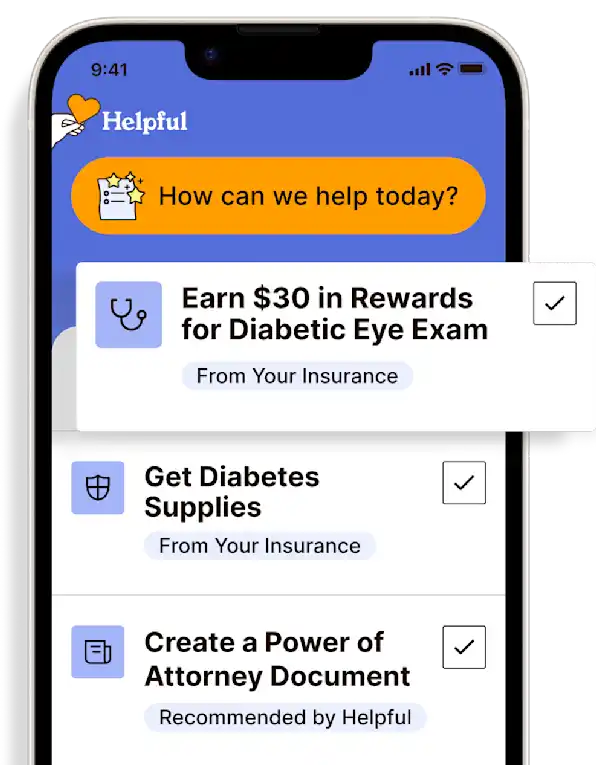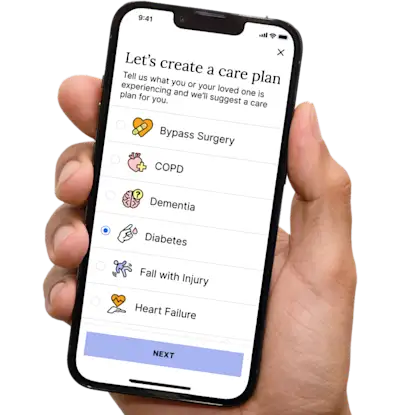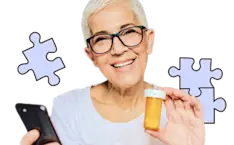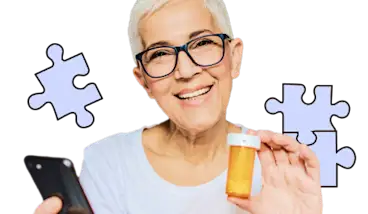Stroke Recovery Timelines
Knowing industry standard timelines and keeping your own timeline of events following a stroke can help reduce anxiousness.
Get insurance benefits, legal documents, and medical records in one place

Helpful Highlights
Experiencing stroke is an emotional roller coaster for your loved one, you, and your family, making it difficult to think about how to care for them afterward.
After 6 months, the rate of recovery from stroke tends to slow down and skills stabilize; however, new milestones can occur for up to 2 years and even beyond.
Familiarize yourself with expert-established timelines, but also maintain your own timeline accompanied by journaling.
At times, the stroke recovery process can be slow and uncertain, and people recover in a range of ways. Although recovery looks different for everyone, it can be helpful to know the stroke recovery timeline established by experts so you can get a sense of what to expect after your loved one's stroke.
Day 1: First 24 hours, hyperacute phase
Initial treatment. Your loved one will likely spend a large portion of Day 1 in the emergency department, where many blood and imaging tests will be performed, and depending on the type of stroke and the time since the onset of symptoms may receive clot-busting medication that can help reduce long-term effects. This is a high-risk medication and your loved one will be closely monitored in the ER and then the ICU.
The rehabilitation team may also evaluate your loved one within 24 hours of hospital arrival.
Days 2-7: Acute phase
Hospital stay. The average length of stay in the hospital for stroke is 5-7 days. During this time the medical team is assessing post-stroke effects and determining your loved one's rehabilitation plan. Spontaneous recovery may occur during this time (temporarily non-functional brain cells recover) and a skill or ability that seemed lost to stroke returns suddenly. Concurrently, bedside - not intensive - physical, occupational, and speech therapy will begin.
Spontaneous recovery is unrelated to the improvements that can be made with therapy.
Week 2 - Month 3: Early subacute phase
Rehab. Spontaneous recovery can continue throughout this period as the brain finds new ways to perform tasks, though it is not guaranteed. Notwithstanding, the first three months after a stroke are the most important for recovery. The brain is very good at "Use it or lose it", so your loved one needs to use it to improve it! Brain plasticity is enhanced in this phase and when your loved one will see the most improvement.
During this time, your loved one will enter and complete a more intensive inpatient rehab program, then move to an intensive outpatient rehab program after discharge from inpatient. Rehab goals are to restore function as close as possible to pre-stroke levels or develop workarounds for functional impairments.
The risk of setbacks such as pneumonia, heart attack, or a second stroke is highest in the months following a stroke, which can have significant impacts physically, mentally, and emotionally, especially if rehab needs to be put on hold.
Months 3-6: Late subacute phase
Coming online. Brain cells that were "offline" may become "online" again because of rehab efforts, though they are not quite the same. They are trying to adapt and find new pathways to bypass damaged pathways but will be a bit sluggish in doing so. Your loved one may be moving or thinking slower and without the accuracy they had before the stroke.
This is also when your loved one is likely to be the most exhausted, and frustrated, and may allow hopelessness to creep in. Your emotional support is critical to continued recovery and you'll need to find ways to remind your loved one that it is a marathon, not a sprint, and that they must keep fighting for a little progress every day because it can lead to big achievements.
Finally, while it may be in your nature as a caregiver to do for them, at this time you need to step back and encourage them to do things themselves; a bit of forcing their brain to think and try and work it out.
Month 6 and beyond: Chronic phase
Steady state. For some, a steady state may mean full recovery. For others, progress may slow but doesn't necessarily stop; improvements are possible. Big improvements and the chances for any spontaneous recovery are not as likely. A particular danger in this phase is the onset of a process known as learned non-use wherein your loved one avoids, forgets, or becomes more resistant to using their affected limbs. Non-use can spawn new complications in blood flow, muscle wasting, and skin breakdown.
It's important to encourage your loved one not to accept plateaus. There is always a way to keep pushing and overcoming barriers. They should not stick to exercises and activities that have become too easy for them but rather switch up their routine to challenge their brain and body in new ways. If possible, they should continue with rehab they consider challenging and intensive.
Prevent another stroke
Having a stroke puts your loved one a high risk of having another one. 1 in 4 strokes each year are repeats. For the best chance of preventing a second stroke:
Work with your loved one's providers to identify the cause of the initial stroke and uncover previously unknown risk factors.
Work with your loved one's providers on a formal program for living a healthier lifestyle and making healthy lifestyle choices.
Schedule regular visits with the members of your loved one's stroke care team (primary care provider, physiatrist, neurologist, PT/OT/ST, and social worker or mental health professional).
Take all medications as prescribed
Manage AFib, blood pressure, cholesterol, and diabetes
Call 9-1-1 immediately if warning signs of stroke appear again
Keep your own timeline
There are many reasons to keep your own recorded timeline of your loved one's recovery. This can be on a notepad, in a journal or diary, in an electronic document, as voice recordings, or any other format with which you're comfortable.
MILESTONES. Track what milestones they acheieved and when. Milestones can be anything of significance - spontaneous recovery occurrences, therapy goals met, time period free of complications, and things your loved one lost to stroke but can now do independently again.
SETBACKS. Track setbacks or complications, what they were, how long they lasted, and their outcomes. This information can help shape the care plan, show how your loved one responds or does not respond to interventions, and provide clues about the root causes of setbacks.
JOURNAL. Daily or weekly journaling can be used to identify trends in your loved one's mood, behaviors, sleep patterns, toileting habits, appetite, and for describing the incremental progress made toward milestones (which can provide insight as to how they got there). If while journaling you pick up on something of importance, you can share it with your loved one's care team. Journaling reveals many subtle but important changes.
SHARE. Timelines and details are also useful for elder care attorneys, estate managers, financial planners, and other family members involved in helping you and your loved one determine their future care needs, from legal documents to living arrangements to end of life and after death care.
RESOURCES
No content in this app, regardless of date, should ever be used as a substitute for direct medical advice from your doctor or other qualified clinician.
Get more support and guidance on insurance benefits, medical records and legal forms.
Helpful brings together your insurance benefits, legal documents, and medical records in one personalized place — so you always know what you have, and never have to search again.

Technology for Health Tasks. Mental Health for the Tough Stuff.
Helpful connects your medical records, insurance, and caregiving tasks automatically. And when you need more than logistics, a therapist is here to guide you.
In-Network and Covered
For Individuals, Couples and Families
HIPAA Compliant, Data Stays Private


Healthcare Tasks Simplified

From syncing records to spotting drug interactions, Helpful does the heavy lifting, turning complex health info into clear tasks and showing you benefits you can actually use, giving you clarity and control over your care.

In-Network Mental Health

Our licensed therapists are here to support you and your loved ones through stress, burnout, and life’s hardest moments, with an inclusive, compassionate approach that works with most insurance plans.

Create Legal Documents

Plan ahead by creating will, trusts, advance directives and more, that ensure your wishes are honored in the event you can’t speak for yourself -with Helpful guiding you every step of the way.